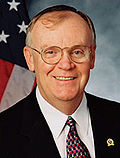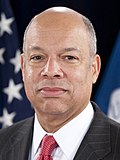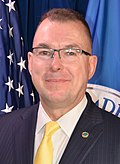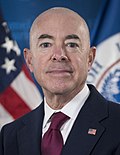United States Secretary of Homeland Security
 From Wikipedia - Reading time: 18 min
From Wikipedia - Reading time: 18 min
| United States Secretary of Homeland Security | |
|---|---|
 Seal of the Department of Homeland Security | |
 Flag of the secretary | |
since January 25, 2025 | |
| Department of Homeland Security | |
| Style | Madam Secretary (informal) The Honorable (formal) |
| Member of | Cabinet Homeland Security Council National Security Council |
| Reports to | President of the United States |
| Seat | St. Elizabeths West Campus, Washington, D.C., U.S. |
| Appointer | The president with Senate advice and consent |
| Term length | No fixed term |
| Constituting instrument | 6 U.S.C. § 112 |
| Formation | January 24, 2003 |
| First holder | Tom Ridge |
| Succession | Eighteenth[1] |
| Deputy | Deputy Secretary |
| Salary | Executive Schedule, Level I |
| Website | dhs.gov |
The United States secretary of homeland security is the head of the United States Department of Homeland Security, the federal department tasked with ensuring public safety in the United States. The secretary is a member of the Cabinet of the United States. The position was created by the Homeland Security Act following the terrorist attacks of September 11, 2001.
The new department consisted primarily of components transferred from other Cabinet departments because of their role in homeland security, such as the Coast Guard, the Federal Protective Service, U.S. Customs and Border Protection (which includes the United States Border Patrol), U.S. Immigration and Customs Enforcement (which includes Homeland Security Investigations), the United States Secret Service, the Transportation Security Administration and the Federal Emergency Management Agency.
The current secretary of homeland security is Kristi Noem, since January 25, 2025.
List of secretaries of homeland security
[edit]Prior to the establishment of the U.S. Department of Homeland Security, there existed an assistant to the president for the Office of Homeland Security, which was created following the September 11 attacks in 2001.
- Parties
Republican (7) Democratic (4) Independent (5)
- Status
Denotes acting homeland security secretary
| No. | Portrait | Name | Senate vote | Term of office | State of residence | President | ||||
|---|---|---|---|---|---|---|---|---|---|---|
| Took office | Left office | Duration | ||||||||
| 1 | 
|
Tom Ridge (Born Aug 26, 1945) |
94–0 | January 24, 2003 | February 1, 2005 | 2 years, 8 days | George W. Bush (2001–2009) | |||
| – | 
|
James Loy[a] (Born Aug 10, 1942) Acting |
– | February 1, 2005 | February 15, 2005 | 14 days | ||||
| 2 | 
|
Michael Chertoff (Born Nov 28, 1953) |
98–0 | February 15, 2005 | January 21, 2009 | 3 years, 341 days | ||||
| 3 | 
|
Janet Napolitano (Born Nov 29, 1957) |
Voice vote | January 21, 2009 | September 6, 2013 | 4 years, 228 days | Barack Obama (2009–2017) | |||
| – | 
|
Rand Beers[b] (Born Nov 30, 1942) Acting |
– | September 6, 2013 | December 23, 2013 | 108 days | ||||
| 4 | 
|
Jeh Johnson (Born Sept 11, 1957) |
78–16 | December 23, 2013 | January 20, 2017 | 3 years, 28 days | ||||
| 5 | 
|
John F. Kelly (Born May 11, 1950) |
88–11 | January 20, 2017 | July 31, 2017 | 192 days | Donald Trump (2017–2021) | |||
| – | 
|
Elaine Duke[c] (Born June 26, 1958) Acting |
– | July 31, 2017 | December 6, 2017 | 128 days | ||||
| 6 | 
|
Kirstjen Nielsen (Born May 14, 1972) |
62–37 | December 6, 2017 | April 10, 2019 | 1 year, 125 days | ||||
| – | 
|
Kevin McAleenan[d] (Born Sept 5, 1971) Acting; unlawful tenure |
– | April 10, 2019 | November 13, 2019 | 217 days | ||||
| – | 
|
Chad Wolf[e] (Born June 21, 1976) Acting; unlawful tenure |
– | November 13, 2019 | January 11, 2021 | 1 year, 59 days | ||||
| – | 
|
Pete Gaynor[f] (Born 1968) Acting |
– | January 11, 2021 | January 20, 2021 | 9 days | ||||
| – | 
|
David Pekoske[g] (Born May 5, 1955) Acting |
– | January 20, 2021 | February 2, 2021 | 13 days | Joe Biden (2021–2025) | |||
| 7 | 
|
Alejandro Mayorkas (Born Nov 24, 1959) |
56–43 | February 2, 2021 | January 20, 2025 | 3 years, 353 days | ||||
| – | 
|
Benjamine Huffman[h] Acting |
– | January 20, 2025 | January 25, 2025 | 5 days | Donald Trump (2025–present) | |||
| 8 | 
|
Kristi Noem (Born Nov 30, 1971) |
59–34 | January 25, 2025 | Incumbent | 197 days | ||||
a. ^ James Loy served as acting secretary in his capacity as Deputy Secretary of Homeland Security.
b. ^ Rand Beers served as acting secretary in his capacity as confirmed Undersecretary of Homeland Security for National Protection and Programs and Acting Deputy Secretary of Homeland Security; Beers was the highest ranking Senate-approved presidential appointee at the Department of Homeland Security.
c. ^ Elaine Duke served as acting secretary in her capacity as Deputy Secretary of Homeland Security.
d. ^ Kevin McAleenan served as acting secretary in his capacity as Commissioner of Customs and Border Protection. His tenure was ruled unlawful.
e. ^ Chad Wolf served as acting secretary in his capacity as Under Secretary of Homeland Security for Strategy, Policy, and Plans. His tenure was ruled unlawful.
f. ^ Peter Gaynor served as acting secretary in his capacity as Federal Emergency Management Agency Administrator.
g. ^ David Pekoske served as acting secretary in his capacity as Administrator of the Transportation Security Administration
h. ^ Benjamine Huffman served as acting secretary in his capacity as Director of the Federal Law Enforcement Training Centers.
Order of succession
[edit]While appointment of acting officials is generally governed by the Federal Vacancies Reform Act of 1998 (FVRA), the Homeland Security Act of 2002 creates exceptions to FVRA, mandating that the under secretary of homeland security for management is third in the line of succession for Secretary of Homeland Security,[2] and establishes an alternate process by which the secretary can directly establish a line of succession outside the provisions of the FVRA.[3]
As of November 8, 2019, the order of succession is as follows.[4] However, the legality of this update was challenged.[3][5][6]
- Deputy Secretary of Homeland Security
- Under Secretary for Management
- Commissioner of the U.S. Customs and Border Protection
- Under Secretary for Strategy, Policy, and Plans
- Administrator and Assistant Secretary of the Transportation Security Administration
- Administrator of the Federal Emergency Management Agency
Formerly, an April 10, 2019 update to the DHS Orders of Succession, made pursuant to the Homeland Security Act of 2002, provided a different order in the case of unavailability to act during a disaster or catastrophic emergency:[4]
- Deputy Secretary of Homeland Security
- Under Secretary for Management
- Commissioner of U.S. Customs and Border Protection
- Administrator of the Federal Emergency Management Agency
- Director of the Cybersecurity and Infrastructure Security Agency
- Under Secretary for Science and Technology
- Under Secretary for Intelligence and Analysis
- Administrator of the Transportation Security Administration
- Director of U.S. Immigration and Customs Enforcement
- Director of U.S. Citizenship and Immigration Services
- Under Secretary for Strategy, Policy, and Plans
- General Counsel
- Deputy Under Secretary for Management
- Deputy Commissioner of U.S. Customs and Border Protection
- Deputy Administrator of the Transportation Security Administration
- Deputy Director of U.S. Immigration and Customs Enforcement
- Deputy Director of U.S. Citizenship and Immigration Services
- Director of the Federal Law Enforcement Training Centers
As a result of Executive Order 13753 in 2016, the order of succession for the secretary of homeland security was as follows:[7]
- Deputy Secretary of Homeland Security
- Under Secretary of Homeland Security for Management
- Administrator of the Federal Emergency Management Agency
- Under Secretary of Homeland Security for National Protection and Programs
- Under Secretary of Homeland Security for Science and Technology
- Under Secretary for Intelligence and Analysis
- Commissioner of U.S. Customs and Border Protection
- Administrator of the Transportation Security Administration
- Director of U.S. Immigration and Customs Enforcement
- Director of U.S. Citizenship and Immigration Services
- Assistant Secretary for Policy
- General Counsel of the Department of Homeland Security
- Deputy Under Secretary for Management
- Deputy Commissioner of U.S. Customs and Border Protection
- Deputy Administrator of the Transportation Security Administration
- Deputy Director of U.S. Immigration and Customs Enforcement
- Deputy Director of U.S. Citizenship and Immigration Services
- Director of the Federal Law Enforcement Training Center
Administration-cited potential nominees
[edit]Bernard Kerik
[edit]George W. Bush nominated Bernard Kerik for the position in 2004. However a week later, Kerik withdrew his nomination, explaining that he had employed an illegal immigrant as a nanny.[8]
Raymond Kelly
[edit]By July 2013, Raymond Kelly had served as Commissioner of the New York City Police Department (NYPD) for nearly 12 straight years. Within days of Homeland Security secretary Janet Napolitano's announcement that she was resigning, Kelly was soon cited as an obvious potential successor by New York senator Charles Schumer and others.[9]
During a July 16, 2013, interview, President Obama referred generally to the "bunch of strong candidates" for nomination to head the Department of Homeland Security, but singled out Kelly as "one of the best there is" and "very well qualified for the job".[10]
Later in July 2013, the online internet news website/magazine Huffington Post detailed "a growing campaign to quash the potential nomination of New York City Police commissioner Raymond Kelly as the next secretary of the Department of Homeland Security" amid claims of "divisive, harmful, and ineffective policing that promotes stereotypes and profiling".[11] Days after that article, Kelly penned a statistics-heavy Wall Street Journal opinion article defending the NYPD's programs, stating "the average number of stops we conduct is less than one per officer per week" and that this and other practices have led to "7,383 lives saved—and... they are largely the lives of young men of color."[12]
Kelly was also featured because of his NYPD retirement and unusually long tenure there in a long segment on the CBS News program Sunday Morning in December 2013, especially raising the question of the controversial "stop and frisk" policy in New York City and the long decline and drop of various types of crimes committed.
Office of the Secretary of Homeland Security
[edit]Purpose
[edit]The Office of the Secretary (OS) oversees the execution of the duties of the Department of Homeland Security.[13] Certain elements also aid the Secretary of Homeland Security and senior officials of the Department of Homeland Security, as well as private sector and government partners in their duties.
Composition
[edit]The Office of the Secretary contains several offices and other elements of the DHS.[13] Most of the heads of these elements report directly to the Secretary or Deputy Secretary, but the Military Advisor and Executive Secretary report to the DHS Chief of Staff, a position that is currently vacant since January 2025.
While DHS Secretary Kristi Noem was participating in an immigration raid on April 8, 2025, she was accompanied by former Trump campaign manager and senior adviser Corey Lewandowski, who introduced himself to the federal agents as “chief of staff.” DHS later clarified that he is an adviser to DHS and a special government employee.[14]
| Component | Mission | Executives | Subordinate Components |
|---|---|---|---|
| Office for Civil Rights and Civil Liberties (CRCL)[15] |
|
|
|
| Office of the Citizenship and Immigration Services Ombudsman (CISOMB)[16] |
|
|
|
| Climate Change Action Group[17] |
|
|
|
| Office of the Executive Secretary (ESEC)[19] |
|
|
|
| Office of the Immigration Detention Ombudsman (OIDO)[21] |
|
|
|
| Family Reunification Task Force[22] |
|
|
Includes the secretaries of Homeland Security, Health and Human Services, and State, as well as the Attorney General. It also includes several other officials from the DHS, DOJ, HHS, and State Department. |
| Office of the General Counsel (OGC)[23] |
|
|
|
| Joint Requirements Council (JRC)[24] |
|
|
The JRC consists of the Principals Council – the operational Components (Cybersecurity and Infrastructure Security Agency, U.S. Customs and Border Protection, Federal Emergency Management Agency, U.S. Immigration and Customs Enforcement, U.S. Secret Service, Transportation Security Administration, U.S. Coast Guard, and U.S. Citizenship and Immigration Services), I&A, Management, CIO, Policy, and S&T. |
| Office of Legislative Affairs (OLA)[25] |
|
|
Each area of responsibility is managed by a director. There's a DAS for the U.S. Senate, a DAS for the U.S. House of Representatives, and a Chief of Staff.
|
| Office of the Military Advisor[26] |
|
|
|
| Office of Partnership and Engagement (OPE)[27] |
|
|
|
| Privacy Office[28] |
|
|
|
| Office of Public Affairs (OPA)[29] |
|
|
|
| Office of Strategy, Policy, and Plans (OSP&P)[30] |
|
|
|
| Office for State and Local Law Enforcement (OSLLE)[31] |
|
|
See also
[edit]References
[edit]- ^ "3 U.S. Code § 19 – Vacancy in offices of both President and Vice President; officers eligible to act". LII / Legal Information Institute.
- ^ Yglesias, Matthew (April 8, 2019). "Trump's possibly illegal designation of a new acting homeland security secretary, explained". Vox. Retrieved April 9, 2019.
- ^ a b Cramer, Harrison; Cohen, Zach C. (November 11, 2019). "Inside Trump's Gambit To Install Another Acting DHS Secretary". National Journal. Retrieved November 15, 2019.
- ^ a b "Letter from House Committee on Homeland Security to U.S. Comptroller General Gene Dodaro" (PDF). U.S. House of Representatives. November 15, 2019. Archived from the original (PDF) on August 21, 2020. Retrieved November 15, 2019.
- ^ Bublé, Courtney (November 15, 2019). "Top Democrats Call for Emergency Review of DHS Appointments". Government Executive. Retrieved November 15, 2019.
- ^ Misra, Tanvi (November 15, 2019). "Legality of Wolf, Cuccinelli appointments to DHS questioned". Roll Call. Archived from the original on November 15, 2019. Retrieved November 15, 2019.
- ^ "Executive Order – Amending the Order of Succession in the Department of Homeland Security". whitehouse.gov. December 9, 2016. Retrieved November 16, 2019.
- ^ Bernstein, Nina (December 16, 2004). "Mystery Woman in Kerik Case: Nanny". The New York Times. Retrieved October 29, 2015.
- ^ "Names already popping as possible Janet Napolitano replacements", by Kevin Robillard and Scott Wong, Politico, July 12, 2013, retrieved July 13, 2013.
- ^ "Obama would consider Ray Kelly to replace Janet Napolitano", by Jennifer Epstein, Politico, July 16, 2013, retrieved July 17, 2013.
- ^ "Muslims Oppose Raymond Kelly Bid For Homeland Security Secretary", by Omar Sacirbey, Huffington Post, August 1, 2013, retrieved August 4, 2013.
- ^ "Ray Kelly: The NYPD: Guilty of Saving 7,383 Lives", by Ray Kelly, Opinion: The Wall Street Journal, July 22, 2013, retrieved August 4, 2013.
- ^ a b "Office of the Secretary | Homeland Security". www.dhs.gov. Retrieved October 12, 2023.
- ^ Taer, Jennie; Nesi, Chris (April 8, 2025). "Kristi Noem dodges kicks from migrant suspect as she leads ICE deportation raids in Phoenix". Retrieved April 9, 2025.
- ^ "Office for Civil Rights and Civil Liberties | Homeland Security". www.dhs.gov. Retrieved October 12, 2023.
- ^ "Office of the Citizenship and Immigration Services Ombudsman | Homeland Security". www.dhs.gov. Retrieved October 12, 2023.
- ^ "Climate Change Action Group | Homeland Security". www.dhs.gov. Retrieved October 12, 2023.
- ^ greenecodemocratcom (August 30, 2023). "DHS Climate Change Action Group (CCAG)". Greene County Democrat. Retrieved October 12, 2023.
- ^ "Office of the Executive Secretary | Homeland Security". www.dhs.gov. Retrieved October 12, 2023.
- ^ "Leadership | Homeland Security". www.dhs.gov. Retrieved October 12, 2023.
- ^ "Office of the Immigration Detention Ombudsman | Homeland Security". www.dhs.gov. Retrieved October 12, 2023.
- ^ "Family Reunification Task Force | Homeland Security". www.dhs.gov. Retrieved October 12, 2023.
- ^ "Office of the General Counsel | Homeland Security". www.dhs.gov. Retrieved October 12, 2023.
- ^ "Joint Requirements Council | Homeland Security". www.dhs.gov. Retrieved October 12, 2023.
- ^ "Office of Legislative Affairs | Homeland Security". www.dhs.gov. Retrieved October 12, 2023.
- ^ "Office of the Military Advisor | Homeland Security". www.dhs.gov. Retrieved October 12, 2023.
- ^ "Partnership and Engagement | Homeland Security". www.dhs.gov. Retrieved October 12, 2023.
- ^ "Privacy Office | Homeland Security". www.dhs.gov. Retrieved October 12, 2023.
- ^ "Office of Public Affairs | Homeland Security". www.dhs.gov. Retrieved October 12, 2023.
- ^ "Office of Strategy, Policy, and Plans | Homeland Security". www.dhs.gov. Retrieved October 12, 2023.
- ^ "The Office for State and Local Law Enforcement | Homeland Security". www.dhs.gov. Retrieved October 12, 2023.
 KSF
KSF